Slugs are soft-bodied worms with snail-like eyestalks. Many people confuse slugs with snails; however, there lies a slight difference between their physical appearances, slugs don’t have hard shells, which makes them different from snails.
Some slugs do have shells, but they are built inside their skin, which they use as a storeroom for minerals and other nutrients. Like snails, they tend to excrete a slimy product that keeps the land moist for them to move through. As the name suggests, their eyestalks are there to help them see, but they also retain a sense of smell.
Right under their eyestalks, slugs have tentacles (mouthparts) that help them eat with the help of a radula, a tongue-like organ that also has teeth, that scoops up food.
Slugs are mostly brown or grey. Their skin is covered with slimy products which provide some defense against predators. This slime can be poisonous in some slugs, which also helps deter their predators.
Usually, slugs are not fond of healthy living plants. They prefer eating dead plants or organisms like algae, fungi, and decomposition products. They are fond of living in vegetation, though, which makes them disliked by many gardeners.
However, they play a significant role in making your soils healthy. They also recycle their food to provide nutrients to the soil.
Table of Contents
What Attracts Slugs the Most
Two primary things that lure slugs are food and dampness. Any spot that remains damp most of the time or during long summer spells will be alluring to these creatures. In particular, they are fascinated by the moisture-maintaining properties of leaf mold, turf, leaves, and straw.
Another draw for slugs is a place where they can lay their eggs. Gardeners have noticed that slugs will often lay eggs in places that have been cultivated, while they will avoid soil that is smoothed by a garden tool. The cracks and lumps left by such tools make an ideal incubation area for slug eggs.

What Do Slugs Eat in General?
Here is a list of things that slugs love eating:
Vegetables
Slugs love consuming vegetables and other soft leaves. They like to have lettuce, cabbage, pepper plants, and other crops.
Fruits
Slugs are attracted towards a chemical called ethylene, which is released by ripened fruits. So, they are inclined to eat fruits like cherries, blueberries, raspberries, etc.
Herbs
Slugs are more interested in eating decayed things, however, if they don’t find anything dead, they can savor other things as well. They are nocturnal they are more likely to attack herbs that are lower to the ground at night.
Lentils
Beans or lentils are known as slug magnets. Lentils are the most vulnerable food to be attacked by slugs.
Flowers
You will also find slugs in flower beds. You might also see them climbing up the stems to savor them.
Organisms
Slugs also like eating other organisms like fungi, algae, molds, etc. Some of the slugs might also attack other slugs or snails to fulfill their appetite.
Types of Slugs and Their Food
There are following some types of slugs and their preference for diet.
1. Dark-margined Glossodoris

Glossodoris is also known as Black-Margined Glossodoris. Another interesting name for this slug is the Cheesecake Nudibranch. They are 2.3 in (6cm) long and are found in the Indo-Pacific region in considerable numbers. They prefer to co-habitat in sandy areas among barrier reefs.
They like to eat corals or sponges particularly Hyatella. They are carnivores; they also prefer eating marine invertebrates.
They suck the toxic elements from their sponge prey and consolidate these chemicals into the mantle gland on their back to then defend themselves from predators.
Crabs, sea spiders, and lobsters tend to attack them.
2. Celtic Sea Slugs
Celtic sea slugs are also called Onchidella celtica. They are mostly found in Western Europe or France. Their sturdy, armor-like body makes their name compatible with them because Celtic means warrior.
Their menu includes diatoms, and they are able to assimilate most of them. They also take in a lot of sand and gravel silts including sponges and foraminifera. Sand plays a significant role in breaking down food before the Celtic sea slug can digest it.
Onchidella celtica also tends to utilize another part of the bio-film family, bacteria. If you ever get to observe Celtic sea slugs you might find them absorbing off mussel beds. When they are under a tide, they can soak up content from there.
3. Banana Slugs

Banana slugs are called so because apparently, they resemble a banana. Banana slugs live in the Pacific Northwest in damp places. If someone questions you regarding the slowest creature on the planet, you could name banana slugs.
These slugs are detritivores and tend to consume dead leaves, mushrooms, animal waste, and other waste materials.
They are eco-friendly and play an important part in bringing a profound change to the environment. They recycle their food into nutrients and make the soil fertile. They also like to eat berries. They are a major source of food for snakes and salamanders.
4. Black Slugs
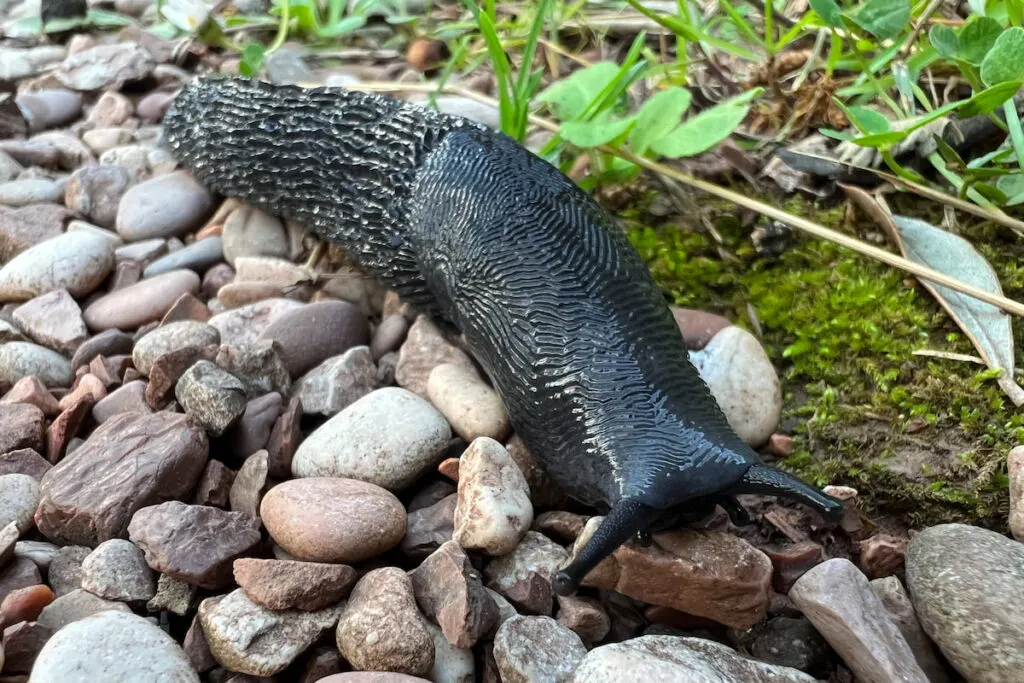
Black slugs are also known as Great Black slugs. They live in an enormous number in Britain. They are found among vegetation, for instance, gardens, lawns, etc. Black slugs tend to leave their habitat at night or after a downpour.
Black slugs are capable of consuming anything. They can eat fungi, moss, different worms, leaves, branches, and decomposed material. They can also live on dung or other waste materials. Their diet is broken down into pieces by a radula and then enzymes digest them.
Predators of these slugs will find their tongues numbed with the anesthetic chemicals contained in their slime.
5. Leopard Slugs
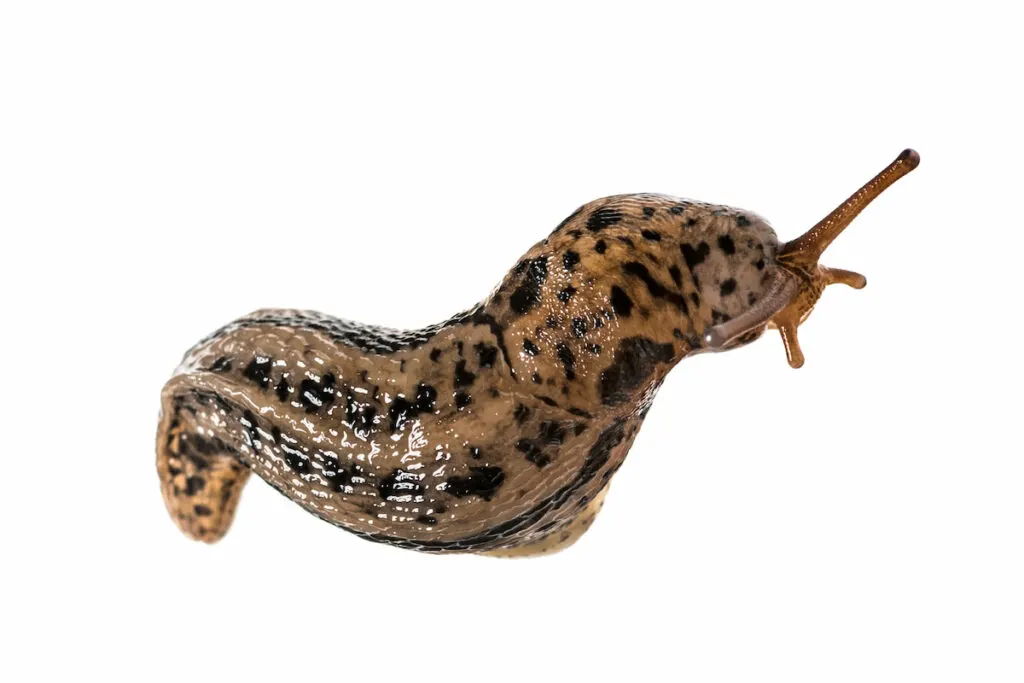
Leopard slugs are an eco-friendly species that live in the United Kingdom. Their skin is brown or grey, or they might also have brown smudges on the skin. These slugs are also fond of consuming decomposed products. They tend to eat dead vegetation including fungi.
Fungi play a role in recycling nutrients that make the soil fertile. Leopard slugs are as agile as real leopards. They chase other slugs or snails to savor.
They live in a garden or among other vegetation, however, they are only interested in dead plants and do not harm the garden.
6. Kerry Slugs
Kerry slugs belong to southwestern Ireland, Portugal, and Spain. They like to live in rural areas or fields and countryside. Their life is threatened by animals grazing in the fields, pollution, or other such factors.
Their favorite foods are fungi, algae, or other material growing on the surface of trees. They have also been known for eating plants, oatmeal, and bread.
Kerry slugs are brown or grey in color with yellow spots. If you touch Kerry slugs, they will roll themselves up in a ball-like shape. The shell on its top is there to protect it from predators.
7. Ocean Beach Slugs
The ocean beach slug is brown with spikes on its oval body. You can see them in the fissures of rocks and coral reefs. New Zealand and Australia are known to have ocean slugs in number. Ocean beach slugs tend to consume algae, moss, and other worms, including tubeworms.
8. Philomycus togatus
Philomycus togatus is a land slug. They are grey with brown smudges on the skin, which come together to make a band on its side. They are nocturnal species, however; they can also be seen in the morning when it rains.
They like eating fungi, lichens, and algae, etc. They tend to habitate under logs or tree branches.
9. Lehmannia valentiana
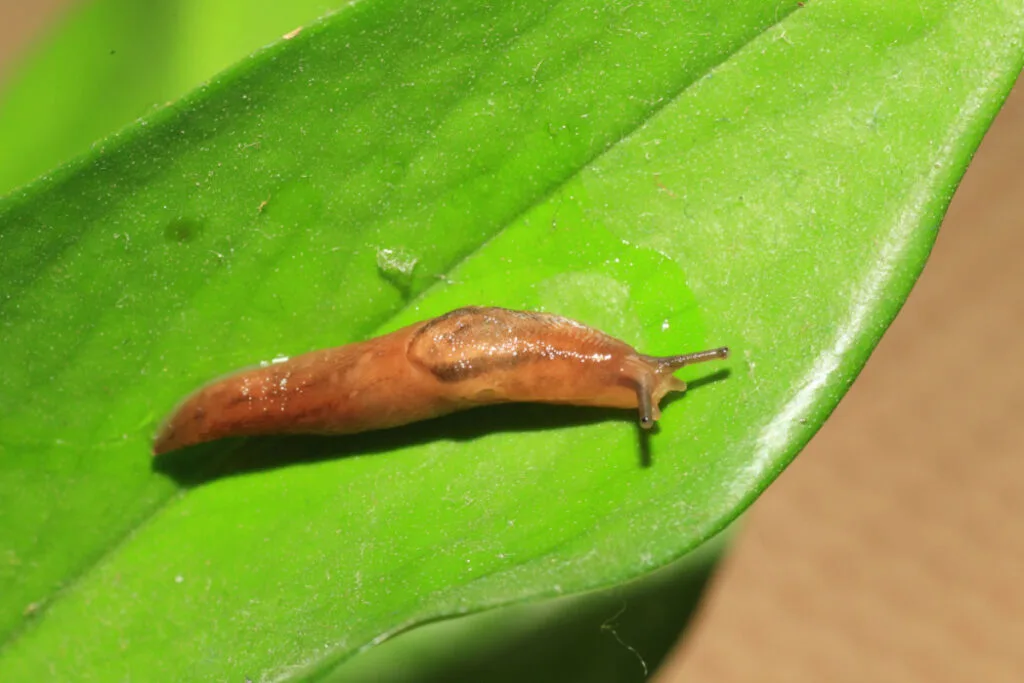
Lehmannia valentiana, also known as three-band slugs, were originally found on the Iberian Peninsula but they have also become part of Europe. You can find these creatures among vegetation.
They also love to reside in home gardens and greenhouses. They like eating rotten wood, plants, and other things related to plants.
10. Egg Shell Slugs
Egg shell slugs are also known by their scientific name, Testacella haliotidea. These snails are sturdy, energetic, and pale brown in color. They are found in Britain, the Western Mediterranean, and the Atlantic coast.
They prefer to live among debris and fallen leaves and only tend to leave their habitat in spring. Their victims are generally earthworms.
11. Deroceras laeve
Deroceras laeve is also called a marsh or meadow slug. They are originally from the Holarctic, but now they are found globally. They tend to live in a variety of places, for instance, in Greenland, and settings such as marshes, gardens, moist places like riverbanks, near oceans, etc.
Their menu includes plants, both dead and alive. Their skin colors include brown, grey, or black. They take refuge under the stones or plant debris to keep them safe from their hunters.
12. Deroceras panormitanum
Deroceras panormitanum is also popularly known as a brownfield slug. Apparently, they might be cream, black or brown in color. They are indigenous to Southwestern Europe, but now they are also a part of countries like Canada, the United States, New Zealand, Australia, and South Africa.
They prefer living among plants or vegetation. Their menu includes plants or other green products. They love eating lettuce, asparagus, root crops, and cereals.
These slugs could be harmful to gardens. They can consume many seeds within the soil. Their tell-tale signs are holes in the leaves of plants.
13. Arion distunctus
Common names that are used for Arion distunctus are Darkface Arion and Mabille’s orange-soled slug. They are natives of Western Europe but are found in other countries like Canada, the United States, New Zealand, and Belgium.
Like other slugs, they are also a grey or brown-colored species. They are found in urban areas. Arion loves consuming vegetables and other green plants.
14. Arion fasciatus
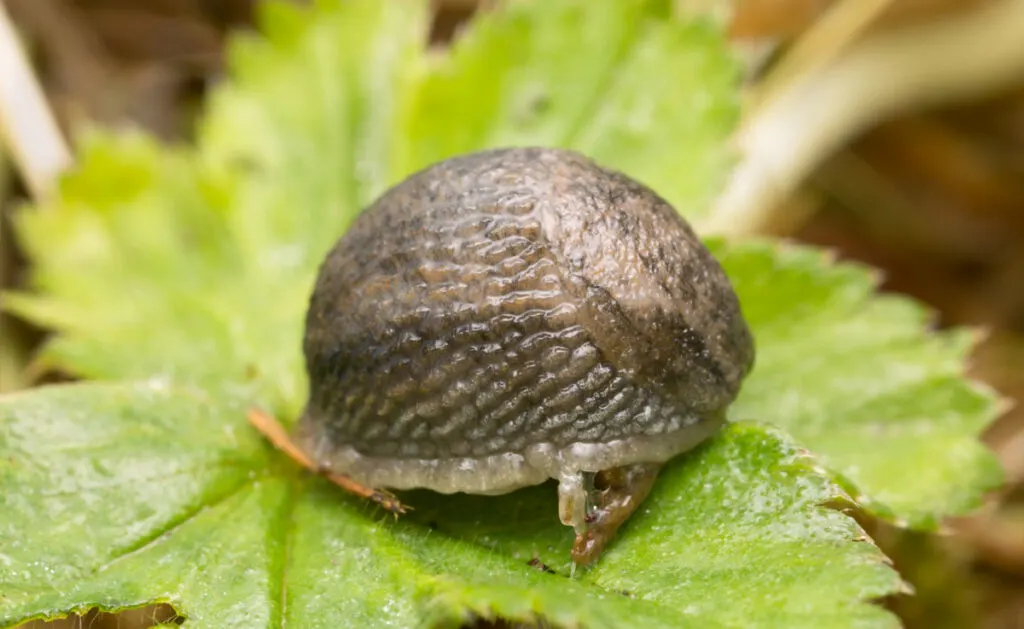
Arion fasciatus is a species that was introduced in North America. It is also called the orange-banded arion. It has orange or brown hues on its skin.
They tend to live in jungles, on the side of streams or rivers, among debris and open planted areas like fields and gardens. They love eating decomposed plants, leaves, earthworms, and tiny arthropods.
15. Arion rufus
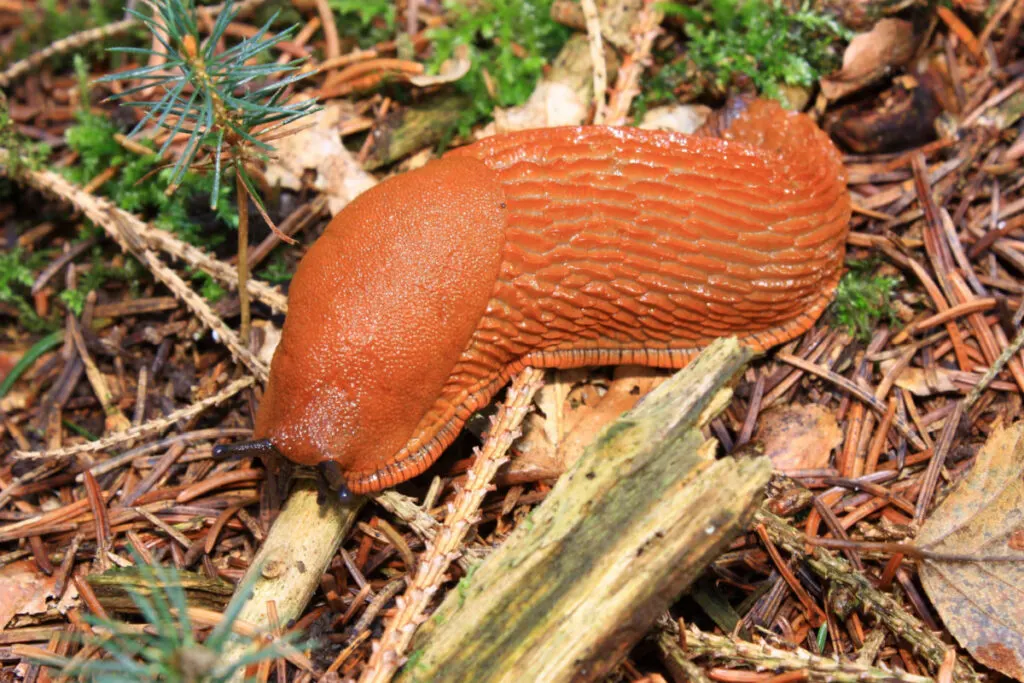
The arion slugs, or chocolate slugs, are giants when compared to other slugs. They are natives of European countries. They prefer living in wet or moist areas like marshes, near rivers, or oceans.
Like other slugs, they love savoring dead plants or debris.
16. Jet Slugs
Jet slugs are indigenous to the western Mediterranean. Jet slugs are fond of living in vegetation, agricultural fields, meadows, and shrublands.
They tend to consume fruits, vegetables like carrots, potatoes, etc. They take refuge under moist stones or debris.
17. Shelled slugs

Shelled slugs are natives of Europe and Africa, but they are populous in other parts of the world as well. They tend to take refuge under debris or underground. Their favorite foods are earthworms, snails, and other slugs.
Are Slugs Harmful to People or Pets?
Generally, slugs are not harmful if they live in your garden because they are most likely to consume plants, leaves, vegetables, or fruits. However, nobody advocates consuming slugs or snails. They are neither edible for pets nor humans.
Some slugs even have poisonous slime which can make you throw up. Secondly, sometimes slugs discharge a lot of mucus to defend themselves, which would lead you to become even sicker. Some slugs even have anesthetic slime which might cause numbness.
Furthermore, some species are permeated with parasitic lungworms which could contaminate you, your pet, or your livestock. If you find your pet consuming slugs, you should consult your vet to provide you with the vaccine to cure lungworm. Some ruminants are also susceptible to lungworm because of their contact with slugs in their pastures.

Bottom Line
Slugs have different preferences according to their types and species. However, in general terms, most slugs prefer to consume dead plants or other dead things. There also occurs a kind that eats other slugs and snails. You can find slugs in moist places anywhere around you.
They roam around roads and other pathways where they are likely to find animal waste and dead leaves or debris. Slugs are not harmful to the fields except for some species. For instance, field slugs might devastate your field. You can identify the harmful slugs by consulting any expert.
You might prevent your plants from being ruined by slugs if you pluck vegetables or fruits before they become overripe because ripened fruits are a big attraction for them. You might also adopt other methods to get rid of snails if you do not want them in your garden.
